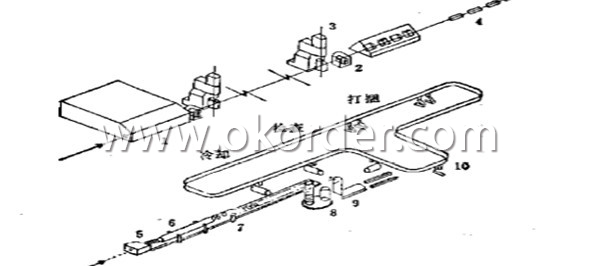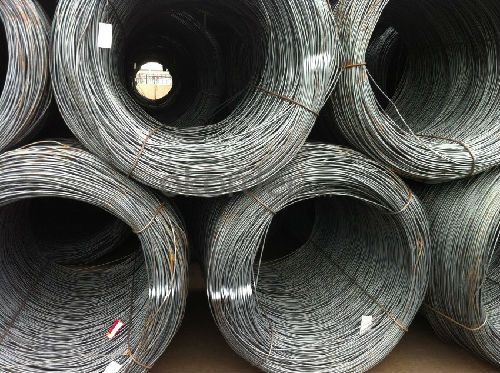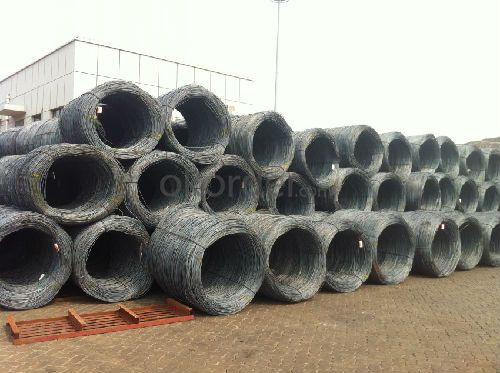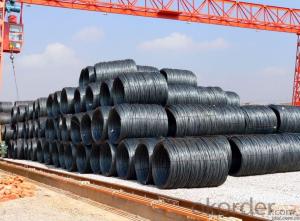Carbon Steel Hot Rolled Wire Rod in Coil
- Loading Port:
- China Main Port
- Payment Terms:
- TT or LC
- Min Order Qty:
- -
- Supply Capability:
- -
OKorder Service Pledge
OKorder Financial Service
You Might Also Like
Product Description:
OKorder is offering Wire Rod at great prices with worldwide shipping. Our supplier is a world-class manufacturer of steel, with our products utilized the world over. OKorder annually supplies products to European, North American and Asian markets. We provide quotations within 24 hours of receiving an inquiry and guarantee competitive prices.
Product Applications:
After hot-rolled the products shaped into coil and delivery as finished product, including round, square, rectangular, hexagonal and so on. Since most of the products are round, it is generally called wire rod. Carbon steel wire rod is widely used in construction and manufacturing. Carbon steel wire rod is mainly used for reinforcement of reinforced concrete and welded structure or reprocessed (roberts , nail, etc.) materials, especially used to produce wire drawing, welding electrode, nails, spring, electronic, precise machinery parts and so on.
Product Advantages:
OKorder's Wire Rod are durable, strong, and resist corrosion.
Main Product Features:
· Premium quality
· Prompt delivery & seaworthy packing (30 days after receiving deposit)
· Corrosion resistance
· Can be recycled and reused
· Mill test certification
· Professional Service
· Competitive pricing
Product Specifications:
Steel Grade: Q195/235, SAE1006-1018B Standard: ASTM, GB
Diameter: 5.5mm, 6.5mm, 7mm,8mm,9mm,10mm,12mm,14mm
Type: in coil, coil weight around 2MT Alloy or Not: Alloy
Surface: round, no twisted, light and smooth Chemical Composition: (Please kindly find our chemistry of our material based on Q195、Q235A and Q235B as below for your information)
Grade | Chemical Composition (%) | |||||
C | Mn | S | P | Si | B | |
SAE1008B | 0.10max | 0.32max | 0.045max | 0.040max | 0.30max | 0.0008min |
Mechanical properties | ||||||
Yield strength(N/mm2) | Tensile strength(N/mm2) | Elongation (%) | ||||
≥195 | 350-380 | ≥32 | ||||
Note:
1. Our products are produced according to national standard (GB), if not, supply according to national standards (GB) or agreement as customer required.
2. Other Grade and Standard carbon steel wire rod we can supply:
Grade: H08A, 30MnSi, 62B-82B
Standard: AISI, BS, JIS, DIN
The Minimum Order Quantity of these products is high, and need to be confirmed.
3. We can not only supply carbon steel wire rod; if you need anything about building materials, please contact us.
4. Please send us your detail specifications when inquire. We will reply to you as soon as possible. We sincerely hope we can establish a long stable business relationship.

1-Furnace 2-Roughing Mill 3-High-speed Finishing Mill 4-Water-cooled Device 5-Coiling Device
6-Cooling Device 7-Chain Conveyer 8-Spool Collecting Device 9-Spool Down Device 10-Hook Conveyer
FAQ:
Q1: Why buy Materials & Equipment from OKorder.com?
A1: All products offered byOKorder.com are carefully selected from China's most reliable manufacturing enterprises. Through its ISO certifications, OKorder.com adheres to the highest standards and a commitment to supply chain safety and customer satisfaction.
Q2: How do we guarantee the quality of our products?
A2: We have established an advanced quality management system which conducts strict quality tests at every step, from raw materials to the final product. At the same time, we provide extensive follow-up service assurances as required.
Q3: How soon can we receive the product after purchase?
A3: Within three days of placing an order, we will begin production. The specific shipping date is dependent upon international and government factors, but is typically 7 to 10 workdays.
Images:


- Q:What are the common industry associations for steel wire rod?
- The common industry associations for steel wire rod include the American Iron and Steel Institute (AISI), the Steel Manufacturers Association (SMA), and the International Wire & Machinery Association (IWMA).
- Q:How is steel wire rod used in the manufacturing of wire rope baskets?
- Steel wire rod is used in the manufacturing of wire rope baskets as it serves as the primary material for creating the wire ropes. The steel wire rod is first drawn into wires of the required diameter, which are then twisted and braided together to form the wire rope. This wire rope provides the structural strength and durability necessary for wire rope baskets to securely hold and transport various items.
- Q:What are the safety considerations when handling steel wire rods?
- When handling steel wire rods, there are several important safety considerations to keep in mind. 1. Personal Protective Equipment (PPE): It is essential to wear the appropriate PPE to protect yourself from any potential hazards. This may include safety glasses, gloves, and steel-toed boots to prevent injuries from falling rods or accidental contact. 2. Proper Lifting Techniques: Steel wire rods can be heavy and awkward to handle. It is crucial to use proper lifting techniques, such as bending your knees and lifting with your legs, to prevent strains or back injuries. 3. Storage and Handling: Steel wire rods should be stored in a designated area that is well-organized and secure. They should be stacked in a stable manner to prevent them from falling over and causing injuries. Additionally, it is important to ensure that the rods are not exposed to moisture or extreme temperatures, as this can affect their integrity. 4. Sharp Edges and Points: Steel wire rods often have sharp edges and points, which can cause cuts or puncture wounds. It is important to handle them with care and use appropriate tools, such as wire cutters or pliers, to avoid direct contact with the sharp areas. 5. Transport and Loading: When transporting or loading steel wire rods, it is essential to secure them properly to prevent them from shifting or falling during transit. This may involve using appropriate tie-downs, straps, or other restraints to keep the rods in place. 6. Training and Awareness: All individuals handling steel wire rods should receive proper training on safe handling procedures and be aware of potential hazards. Regular safety meetings and reminders can help reinforce the importance of following safety protocols. By considering these safety measures, you can help mitigate the risks associated with handling steel wire rods and ensure a safe working environment for all involved.
- Q:How is steel wire rod used in the manufacturing of nails?
- Steel wire rod is an essential raw material used in the manufacturing of nails. It is first drawn through a series of dies to decrease its diameter and increase its length, resulting in a thinner and longer wire. This wire is then cut into appropriate lengths and fed into a nail-making machine. The machine forms the wire into the shape of a nail, cuts the nail to the desired length, and adds a head or point if necessary. Steel wire rod provides the strength and durability required for nails to hold materials together securely.
- Q:What are the main factors affecting the waste generation of steel wire rod production?
- The main factors affecting the waste generation of steel wire rod production include the quality of raw materials used, the efficiency of production processes, the effectiveness of waste management systems, and the implementation of sustainable practices.
- Q:How are steel wire rods used in the production of wire cables for transmitting signals?
- Steel wire rods are essential components in the production of wire cables used for transmitting signals. These rods are initially manufactured by hot rolling billets of low carbon steel into long, thin shapes. This process ensures that the steel wire rods have the necessary strength and flexibility required for their application in wire cable production. Once the steel wire rods are obtained, they undergo various steps to transform them into wire cables capable of transmitting signals. The first step involves cleaning and coating the rods to prevent corrosion and improve their durability. This coating can be made of zinc, copper, or other materials depending on the specific requirements of the cable. After the rods are coated, they are then drawn through a series of dies to decrease their diameter and increase their length. This drawing process further enhances the strength and flexibility of the rods, making them suitable for the demanding conditions that wire cables may encounter during installation and use. The drawn steel wire rods are then twisted or braided together to form the core of the wire cable. This core provides the necessary mechanical strength and stability for the cable, allowing it to withstand tension and external forces. The number of rods used in the core can vary depending on the desired strength and thickness of the cable. To ensure efficient signal transmission, the core is covered with an insulating material, typically made of plastic or rubber. This insulation protects the core from damage, prevents electrical interference, and maintains the integrity of the signal being transmitted. Finally, the completed wire cables are tested to ensure their quality and performance. They are inspected for any defects or imperfections that could affect their ability to transmit signals effectively. Once approved, these cables are ready to be used in various applications, such as telecommunications, electrical systems, and data transmission. In summary, steel wire rods play a crucial role in the production of wire cables used for transmitting signals. They provide the necessary strength, flexibility, and durability to withstand the demanding conditions that wire cables may encounter. Through a series of processes, these rods are transformed into wire cables capable of efficiently transmitting signals while maintaining their mechanical integrity.
- Q:How is the corrosion resistance of steel wire rod evaluated?
- Various methods and tests are utilized to assess the corrosion resistance of steel wire rod. One commonly employed technique is the salt spray test, which is also known as the ASTM B117 test. During this test, the steel wire rod is exposed to a controlled environment of saltwater spray for a specific duration. Subsequently, the wire rod is inspected for any indications of corrosion, such as rust or discoloration. Another approach employed to evaluate corrosion resistance is the electrochemical test, such as the measurement of polarization curves. This test entails immersing the steel wire rod in an electrolyte solution and administering a small electric current. The resultant polarization curve provides information regarding the rate of corrosion and the propensity of the wire rod to corrode. Moreover, visual inspection and microscopic examination of the wire rod's surface can be conducted to identify any signs of corrosion, such as pitting or surface roughness. These evaluations are often supported by various corrosion measurement techniques, including analysis of weight loss, measurement of corrosion potential, and determination of corrosion rate. To summarize, the corrosion resistance of steel wire rod is evaluated through salt spray tests, electrochemical tests, visual inspection, and microscopic examination. These evaluations furnish valuable information about the wire rod's capacity to withstand corrosion and ensure its suitability for diverse applications.
- Q:How is steel wire rod used in the manufacturing of wire for automotive braking systems?
- Steel wire rod is a vital component in the manufacturing of wire for automotive braking systems due to its exceptional strength and durability. The process begins with the selection of high-quality steel wire rod, which is then subjected to a series of manufacturing processes to create the wire used in automotive braking systems. Firstly, the steel wire rod is carefully examined and tested to ensure it meets the required specifications and standards for automotive braking systems. This is crucial as the wire needs to withstand the immense forces and pressures exerted during braking, ensuring the safety and reliability of the braking system. Once the steel wire rod passes the quality tests, it undergoes a process called wire drawing. In this process, the steel wire rod is pulled through a series of dies, gradually reducing its diameter while increasing its length. This results in a wire with a smooth and uniform surface, enhancing its ability to resist wear and corrosion. After wire drawing, the wire is further processed through heat treatment. This involves subjecting the wire to controlled heating and cooling processes, such as annealing or quenching, to enhance its mechanical properties. Heat treatment helps to increase the wire's tensile strength, hardness, and resistance to deformation, making it suitable for the demanding conditions of automotive braking systems. Next, the wire is coated with a protective layer, usually made of zinc or other corrosion-resistant materials, through a process called galvanization. This coating provides an additional layer of protection against rust and corrosion, extending the lifespan of the wire and ensuring its performance in harsh environments. Finally, the wire is further processed to meet the specific requirements of automotive braking systems. It may be shaped, cut, or formed into various components, such as brake cables, brake pads, or brake springs. The strength, durability, and reliability of the steel wire rod used in the manufacturing of wire for automotive braking systems contribute to the overall performance and safety of the braking system. In conclusion, steel wire rod plays a vital role in the manufacturing of wire for automotive braking systems. Its exceptional strength, durability, and resistance to wear and corrosion make it an ideal material for withstanding the extreme forces and conditions experienced during braking. By using high-quality steel wire rod, automotive manufacturers can ensure the production of reliable and safe braking systems.
- Q:What are the different international standards for steel wire rod?
- There are several international standards for steel wire rods, including ASTM A510, JIS G3506, DIN 17140, and BS EN 10016-2. These standards specify the requirements for the chemical composition, mechanical properties, dimensions, and tolerances of steel wire rods used in various industries. Compliance with these standards ensures the quality and consistency of steel wire rods produced and traded globally.
- Q:What is the tensile strength of steel wire rod?
- The tensile strength of steel wire rod depends on various factors such as the composition and manufacturing process. However, on average, steel wire rod has a tensile strength ranging from 400 to 700 megapascals (MPa).
1. Manufacturer Overview |
|
|---|---|
| Location | |
| Year Established | |
| Annual Output Value | |
| Main Markets | |
| Company Certifications | |
2. Manufacturer Certificates |
|
|---|---|
| a) Certification Name | |
| Range | |
| Reference | |
| Validity Period | |
3. Manufacturer Capability |
|
|---|---|
| a)Trade Capacity | |
| Nearest Port | |
| Export Percentage | |
| No.of Employees in Trade Department | |
| Language Spoken: | |
| b)Factory Information | |
| Factory Size: | |
| No. of Production Lines | |
| Contract Manufacturing | |
| Product Price Range | |
Send your message to us
Carbon Steel Hot Rolled Wire Rod in Coil
- Loading Port:
- China Main Port
- Payment Terms:
- TT or LC
- Min Order Qty:
- -
- Supply Capability:
- -
OKorder Service Pledge
OKorder Financial Service
Similar products
New products
Hot products
Related keywords



























